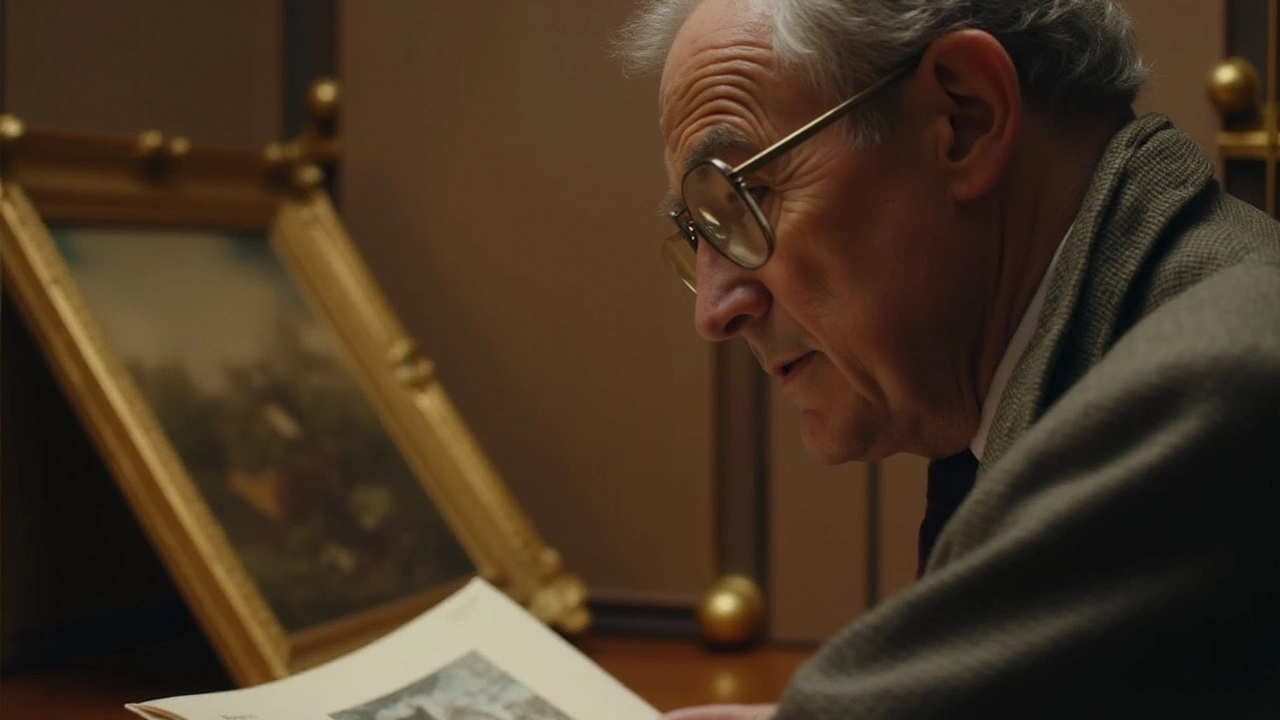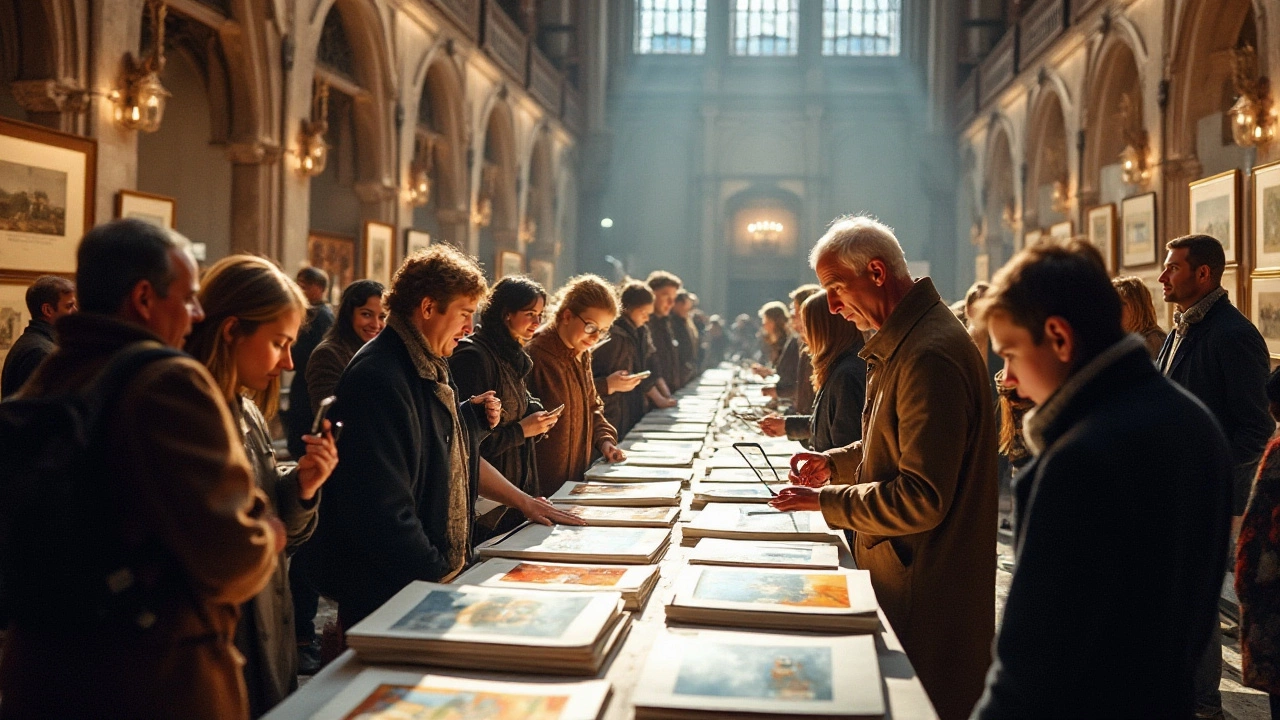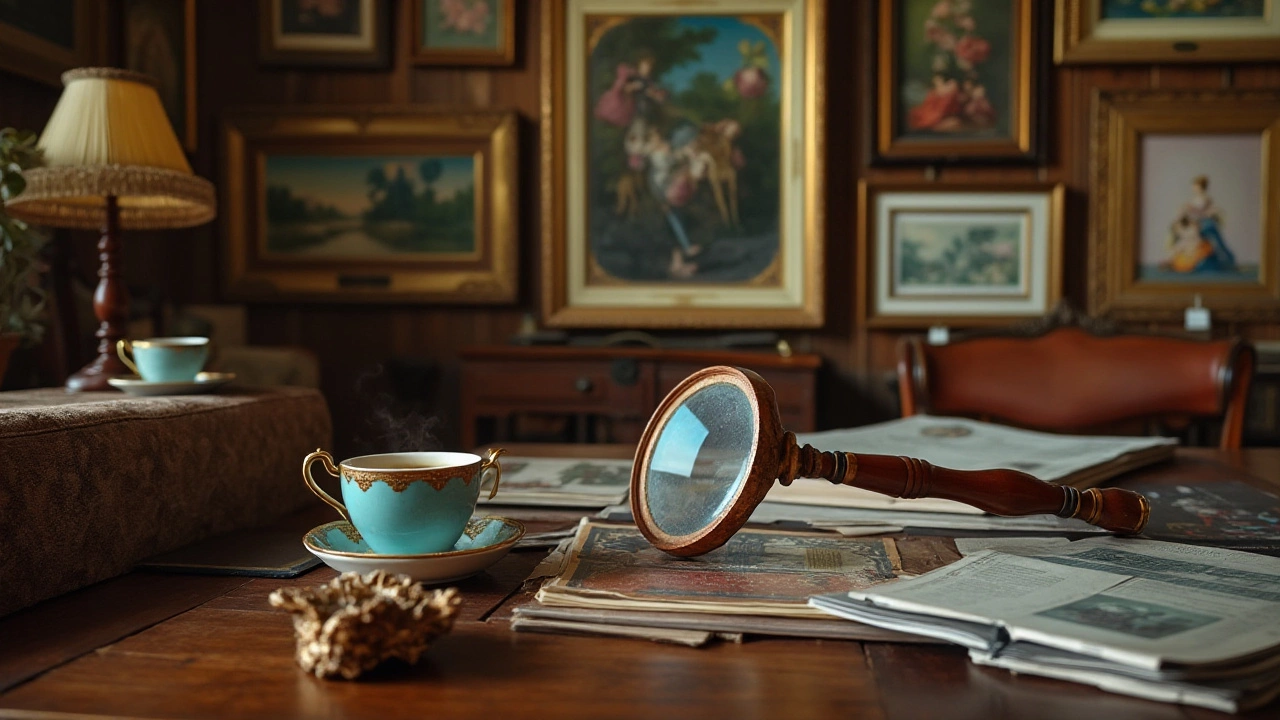Art prints encompass a fascinating world where aesthetics and potential appreciation tell a captivating story. Diving into this realm requires both a keen eye and some knowledge to discern pieces with true value from those without.
Determining the worth of an art print can sometimes feel like unraveling a mystery. Is it the artist's fame, the unique signature, the scarcity of editions, or the gentle aging of its paper that holds the key? Each factor plays a part in the intricate puzzle of assessing potential and value.
Whether you're an experienced collector or just tipping your toes into the vast ocean of art, this guide will help you navigate through important aspects to consider. So, let's explore how you can unveil the true value of art prints with confidence and curiosity.
- Identifying the Artist and Signature
- Understanding Editions and Rarity
- Condition and Preservation
- Provenance and Historical Context
- Market Trends and Demand
Identifying the Artist and Signature
When you first gaze upon an art print, the artist's name acts as an immediate gateway into its history and value. Identifying the artist is not just a cursory step; it's crucial for assessing the potential worth of an art print. The signature can be the most direct evidence of the artist's involvement in the creation of the piece, but don't overlook the weight of style, technique, and historical context in linking a print to its creator. Take, for instance, the significance of a Picasso signature versus an unknown artist. A signature that's authenticated as genuine can transform an art print from a decorative piece into a substantial investment.
The size and placement of the signature on a print can also provide hints about its origin. Many prints bear signatures in the lower-right corner, often accompanied by numbers or letters indicating its edition. Is the signature hand-written or does it appear mechanically reproduced? This distinction may determine a piece's originality. Hand-signed prints indicate direct involvement, such as signing limited edition prints, whereas reproduced signatures can be a red flag for mass production. Rare prints often come with certificates of authenticity, aligning provenance with historical documentation.
High-profile artists like Salvador Dali have had their signatures forged, making authentication pivotal. As stated by the International Foundation for Art Research, "signatures alone are not proof of authenticity unless all other factors align with the artist's known practices and history." Pay attention to the paper quality, print techniques, and watermarking that resonate with the artist's era. These subtle details weave together a narrative of authenticity. Photographic analysis and infrared techniques often assist experts in their assessments, though true mastery comes with time and experience.
Consider the practices of artists like Andy Warhol, who utilized multiple methods of distribution. His prints bore stamps from his studio, offering a layer of validation beyond the artist's own mark. Understanding the nuances behind these practices requires not only recognizing the signature but also employing a critical eye towards the print's edition and limitations. Engaging with this process brings about a more profound connection to the art world while amplifying the thrill of exploration and discovery as you track down a fully authenticated piece of art.
Ultimately, identifying an artist’s signature invites you into a deeper dialogue with the print itself. It encourages exploration of art history, demands awareness of market trends, and rewards diligence with the satisfaction of owning a genuine piece of art history. Whether you stumble upon an overlooked gem at an estate sale or spotlight a coveted piece in a gallery, understanding the nuance in a signature is an essential skill, a beacon illuminating the artistry within. Embrace the role of detective as you peer into the past, continuously learning and appreciating the richness each piece carries with it. The artist and their signature are but the opening chapter of the story every art print tells.
Understanding Editions and Rarity
When it comes to art prints, terms like 'edition' and 'rarity' often drift through conversations like whispers, carrying with them the promise of value and exclusivity. Editions refer to the number of prints produced within a specific run. Often, this number can transform a mere piece into a prized possession. The concept of editions highlights the delicate balance between accessibility and exclusiveness that characterizes the art world. Limited editions, numbering in the hundreds, often command greater admiration than open editions, which are unnumbered and lack a finite quantity.
Understanding the nuances of editions is crucial for collectors seeking value. Limited editions, particularly those numbered and signed by the artist, can signify both a degree of scarcity and an artist's endorsement. It's intriguing to know that some artists choose to release prints as artist proofs. These are separate from the main edition and often kept for personal use or given to close friends. Their rarity in the market makes them even more desirable. And then there are trial proofs, used by artists to experiment with colors or techniques, making each slightly different and adding a unique charm to their stature.
"In the world of art collecting, rarity is currency," echoes renowned art critic Jonathan Jones. "A limited run amplifies an art print’s desirability and potential market value."
One might ask how a print's rarity is determined. Beyond the number of prints in a run, factors can include the artist's fame and the print's complexity. Prints by well-known artists, limited by nature, often attract collectors, eager to own a piece of history. On the technical front, a more labor-intensive print, for instance, those that might employ rare techniques or tools, tend to be valued more highly. The uniqueness of the technique, coupled with artistic vision, plays a layer in determining the overall rarity.
Exploring the Role of Editions in Art's Market Dynamics
A fascinating aspect of editions comes into play when examining market dynamics. The price of a print can rise proportionately with the decrease in its availability, especially when an edition sells out. This introduces urgency, enticing collectors to acquire a print before it becomes unavailable. An artist's early work, often released in smaller editions, might appreciate in value as the artist gains renown. This phenomenon creates a fervent market for collectors hoping to invest in future legends. A deeper dive into art trends shows a pattern where early editions of famous works surge in value posthumously, the Bertha Morisot's prints being a vivid example, illustrating how fame and time blend with rarity to affect value.
Key Examples and Statistical Insights
Historically, a limited edition by a renowned artist like Andy Warhol can fetch prices far above an open edition from a lesser-known name. To illustrate, consider the iconic "Marilyn Monroe" series: despite being part of a larger set, each print’s limited nature and Warhol's enduring legacy help maintain its sky-high appraisal. A study from The Art Market suggests that art prints of limited editions see a 50% higher appreciation over a decade compared to their open edition counterparts. This isn't merely an art collector's myth but a statistically-backed reality.
So, whether you're just beginning your collection journey or seeking that next masterpiece, understanding editions and rarity offers invaluable insights into the rich tapestry of art collecting. It's not just about possessing art; it’s about understanding its hidden nuances and stories.

Condition and Preservation
When evaluating the worth of art prints, the condition of the piece is paramount. A well-preserved print can command a far higher price than one that has suffered the ravages of time. Art prints, like any collectibles, tell stories not just in their images but also in their physical presence. Every crease, stain, or fading partakes in the narrative, and collectors often seek to uncover prints that keep their tale pristine and intact. The importance of condition cannot be underestimated, as the art world often draws a strict line between well-preserved pieces and those that are damaged. Exposure to sunlight, humidity, and improper framing can lead to significant deterioration, which any serious collector or aficionado should vigilantly guard against.
Care of art prints often requires understanding of both the immediate signs of degradation and the more subtle ones that can occur over time. For instance, fading can sometimes be deceptively gradual, making it less noticeable initially but detrimental in the long run. Paper quality is another critical factor. Prints made on acid-free paper tend to last longer without yellowing, which can significantly affect their aesthetic appeal and thus their value. Collectors have learned to scrutinize not simply the visible image but also the medium itself. “The medium is the message,” renowned media theorist Marshall McLuhan once penned, a notion that resonates profoundly with art print collectors.
One might wonder how to effectively maintain these delicate treasures. Controlling the environment where the prints are stored or displayed is essential. Temperature fluctuations should be minimized, as they can lead to expansion and contraction of the paper, causing warping or worse. Utilizing archival-quality framing and UV-protective glass can also play a crucial role in maintaining a print's condition. Humidity is a silent foe; maintaining a balanced humidity level around 50% can prevent mold, mildews, and ink bleeding. Collectors often find themselves almost like caretakers, preserving these pieces for the appreciation of future generations. Conservators, experts who specialize in the preservation of such items, often recommend using acid-free mats and backing boards for framing to ensure longevity.
In terms of assessing current conditions, collectors should be astute in looking for discolorations, tears, watermarks, and signs of previous restorations. Each factor influences the market perception of a print's value. A print in mint condition might fetch many times its historical auction results, which are often published by auction houses and can be accessed for guidance. Some collectors swear by specialized print dealers who can provide a full evaluation of a print’s condition, articulating what any signs of wear might mean for a prospective buyer. Utilizing this professional expertise can save one from costly mistakes and help ensure a collection retains its integrity and potential market value.
The steps one takes to preserve the art can sometimes seem taxing, but they're a vital investment in the art's future. Whether for aesthetic enjoyment or financial investment, preserving the condition and learning proper care techniques help maintain the art's story as much as its value. Remember, the aura of authenticity, the legacy that each print holds, is greatly determined by the care it receives. Keep the condition and preservation as your north star as you navigate your journey through collecting art prints, and you will undoubtedly find the endeavor as rewarding as it is enriching.
Provenance and Historical Context
Diving into the world of art prints, one might find that the story behind the piece adds a layer of allure and significance. This story, known as provenance, often serves as a key in unlocking the value of prints. Provenance refers to the ownership history of an artwork. Tracking a print’s journey over time offers insights into its authenticity and worth. Imagine holding a print that once graced the halls of a royal palace or hung in a renowned art museum. Such a rich history elevates its desirability among collectors, making provenance a vital part of valuation.
Delving into the provenance of art prints involves detective-like scrutiny, requiring documentation that supports each ownership claim. This trail could include invoices, gallery stamps, or auction receipts, weaving a narrative that enriches the print’s history. However, it is important to be cautious of gaps or unverifiable links, as these can raise questions about authenticity. The historical context of when and why a print was made also adds depth. For instance, prints created during the Renaissance or at the height of the Art Nouveau movement provide a snapshot of cultural shifts, reflecting societal tastes and technological advancements of their time.
Another aspect to consider is the print's role and influence throughout its existence. Did it inspire a cultural movement, or was it a part of a renowned artist’s pivotal series? Such questions can enhance both scholarly interest and financial value. A print’s connection to historical events or its reflection of those times can amplify its significance. For instance, artwork that comments on social issues or encapsulates a particular artistic innovation can become treasured for its insight and bold expression.
While tracing provenance, researchers often delve into archives and specialist databases. Museums and libraries frequently house records that are crucial in piecing together a print's past. Personal connections and stories, passed down through collectors or art dealers, can sometimes provide the missing links necessary to complete a provenance trail. It’s also worth noting high-profile cases where provenance played a key role. In 2011, the sale of Edvard Munch’s ‘The Scream’ fetched a staggering $119.9 million, not only because of its visual impact but partly due to its well-documented provenance.
"Provenance is the DNA of a work of art, intricately entwined with its identity and value," remarked art historian Judith Wallace, encapsulating the essence of provenance in art collecting.
For emerging collectors and seasoned aficionados alike, understanding provenance and historical context can turn the quest for art prints into a rewarding journey of discovery. Given the complexity and nuances of provenance, it becomes evident why this component of art valuation is both fascinating and essential, offering depth to the narrative of rare prints in the art collecting world.

Market Trends and Demand
The art prints market is a dynamic space, constantly shifting with the ebb and flow of societal interests, economic indicators, and popular media influences. Collectors often find themselves swayed not only by the aesthetic virtues of a piece but by how in-demand artworks are in the current climate. In recent years, there has been a noticeable surge in interest towards art prints from emerging artists, particularly those who have harnessed social media platforms to build an audience. This not only democratizes the art world by giving voices to underrepresented groups but also brings a level of unpredictability to market trends.
Economists and cultural analysts often point to periods of economic downturn as times when the art market, paradoxically, experiences a spike in activity, especially with art prints. This is often attributed to investors seeking more stable assets that hold and even increase in value over time. During the early 2020s, for example, as uncertainties grew in various global markets, art prints became increasingly attractive due to their relatively lower price points compared to original artworks. This accessibility enables new collectors to enter the market, with demand rising significantly for limited edition prints.
Market trends can be influenced by exhibitions and retrospectives that shed light on previously overlooked artists. Art collecting communities on online forums and dedicated websites have become bustling havens for these discussions, driving up demand for certain prints almost overnight once a consensus forms on a particular artist's re-evaluation. A shift towards eco-conscious art production has also become evident, with collectors showing preference for prints made with sustainable materials, bringing an ethical dimension to their acquisitions.
As renowned art critic Jerry Saltz once mentioned, "The moment a trend is declared, it's already on its way out. What's important is nurturing an understanding of art that allows you to see beyond trends."
This nuanced understanding highlights how crucial it is for a collector to stay informed beyond just current fads. When assessing the value of prints, savvy collectors often take note of auction sales data. For instance, according to Artsy, the sale of prints by renowned urban artist Banksy soared by 260% from 2021 to 2023. Such statistics offer a glimpse into market appetites and can guide buyers on which art prints are thriving in terms of popularity and financial potential.
Ultimately, the sophistication of market trends demands a keen eye and strategic thinking. Valuation isn't only about raw data – it's about an instinctual feel for the cultural currents that are shaping public consciousness. By staying knowledgeable, collectors are able to make more informed choices, maximizing both the aesthetic enjoyment and monetary value of their art portfolios.

